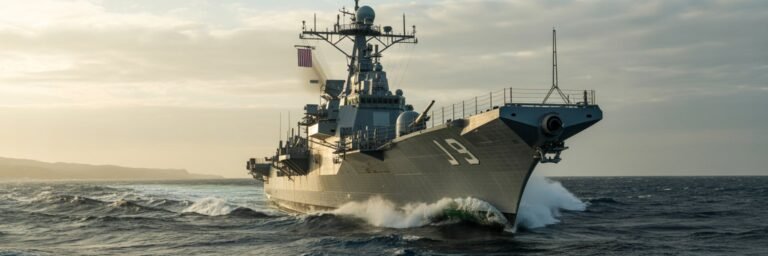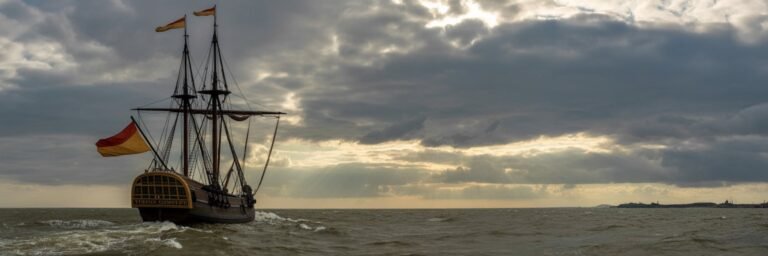INTRODUCTION
Perched high on her perch above the rolling waves, the watchful galleass keeper squints against the horizon’s gleam. His vigilant gaze peruses the vast expanse of water, searching for the familiar silhouette of a billowing sail. This might seem like a description from a bygone era—a time when naval warfare held sway over global politics. However, even in the technologically advanced 21st century, the underlying truth remains: naval warfare continues to be of great significance. This article will journey through the evolution and significance of naval warfare, diving into uncharted waters to explore theories, controversies, societal symbolism, recent research, and the enduring legacy of this timeless form of combat.
HISTORICAL BACKGROUND
Naval warfare’s origins are as old as civilization itself. Ancient Sumer, circa 3000 BC, utilized riverine vessels for military purposes, pioneering naval tactics that would remain in use for millennia. Fast forward to the 5th century BC, when the Greco-Persian Wars showcased the strategic value of naval dominance. The Battle of Salamis was a decisive event, where the Athenian-led Greek city-states’ naval prowess led to victory over the Persian armada.
The Middle Ages were characterized by Viking longships conquering the North Sea, while the Mediterranean saw the rise of the Byzantine navy, famed for their innovative “Greek fire.” The age of exploration had its warships too—Portuguese carracks, Spanish galleons, and English men-of-war ruled the colonial-era seas.
The advent of the Industrial Revolution in the 19th century ushered in ironclads, steam power, and explosive shells, culminating in dreadnoughts—floating steel fortresses that were the pride of every great power’s navy. World War II saw the apex of battleship warfare, richly illustrated by the clash at Leyte Gulf. However, it was during this conflict that the supremacy of the aircraft carrier emerged, signaling the changing nature of naval warfare.
THEORIES AND INTERPRETATIONS
The influence of naval warfare has invited serious academic discourse. Alfred Thayer Mahan’s work titled “The Influence of Sea Power upon History,” written in 1890, emphasized the decisive role navies play in shaping world history. Mahan argued that a strong navy was crucial to a country’s ambition of becoming a world power—a proposition exemplified by Britain’s imperial expansion facilitated extensively by its command over the sea.
On the other hand, Julian S. Corbett, in his seminal work “Some Principles of Maritime Strategy,” argued that sea control wasn’t an end in itself, but a means to project military power ashore. He posited that the function of navies was flipped—it supported land and air forces, instead of being the primary offensive asset.
MYSTERIES AND CONTROVERSIES
The hallowed annals of naval warfare are not without their share of mysteries and controversies. Did the Greeks really use a mirrored “death ray” to set Persian ships afire during the Siege of Syracuse in 212 BC, as claimed by some? Or consider the enigmatic tale of the USS Philadelphia—found intact but abandoned in 1872. Did the crew fall victim to a pirate attack, mutiny, or something more sinister?
The mighty dreadnoughts’ controversial obsolescence during WWII remains a hotly debated topic among military historians. Some argue that a failure to adapt these titanic vessels for anti-aircraft roles led to their downfall, while others insist that their demise was inevitable given the rise of submarine and aerial warfare.
SYMBOLISM AND CULTURAL SIGNIFICANCE
Naval warfare is deeply embedded in our cultural consciousness. Sailors singing shanties aboard tall ships spark romantic notions of adventure on the high seas, despite the stark reality of shipboard warfare. Battleships, carriers, and submarines are symbols of national pride and power, visible in every major navy’s celebrations or the utilization of warships as floating museums—educational and poignant reminders of our martial past.
The notion of ‘ruling the waves’ is central to the national identity of many countries. Britain’s “Rule, Britannia!”—an assertive anthem reinforcing the country’s historical dominance at sea—is a vivid example of this maritime symbolism.
MODERN INVESTIGATIONS
Naval warfare remains at the forefront of strategic military operations. Modern investigations highlight the increasing importance of technological advancements within this realm. The rise and sophistication of Anti-Access/Area Denial (A2/AD) strategies, utilized by nations to prevent adversaries from operating in their near seas, emphasize the maritime sphere’s ongoing significance.
In addition, today’s geostrategic landscape demonstrates that control of vital sea lanes is more important than ever. Crucial choke points—like the Straits of Hormuz and Malacca, not to mention the Arctic Sea Route—are flashpoints underscoring the role of sea control in ensuring national security and economic prosperity.
LEGACY AND CONCLUSION
Though many view oversized battleships lumbering across the high seas as relics of another era, the world’s navies, their vessels, and maritime warfare’s principles remain critically relevant. On every ocean, ships of war stand ready, their presence serving as both deterrent and promise.
The legacy of naval warfare is a compelling testament to human ingenuity, adaptability, and the relentless pursuit of dominance over the globe’s greatest highways—the oceans. Politically, culturally, and militarily, the wargame on the high seas continues, shaping world history as decisively now as it did in the time of Greek fire and Viking longships.
In cognizing naval warfare’s historic odyssey, it is worth contemplating the words of Walter Raleigh: “Whoever commands the sea, commands trade; whoever commands the trade of the world commands the riches of the world, and consequently the world itself.” Naval warfare’s echoes, from ancient galleass to modern carriers, are a resonating reminder of this inexorable truth. Thus, in the grand symphony of world history—past, present, and future—the rhythm of the sea continues to play its crucial part.




